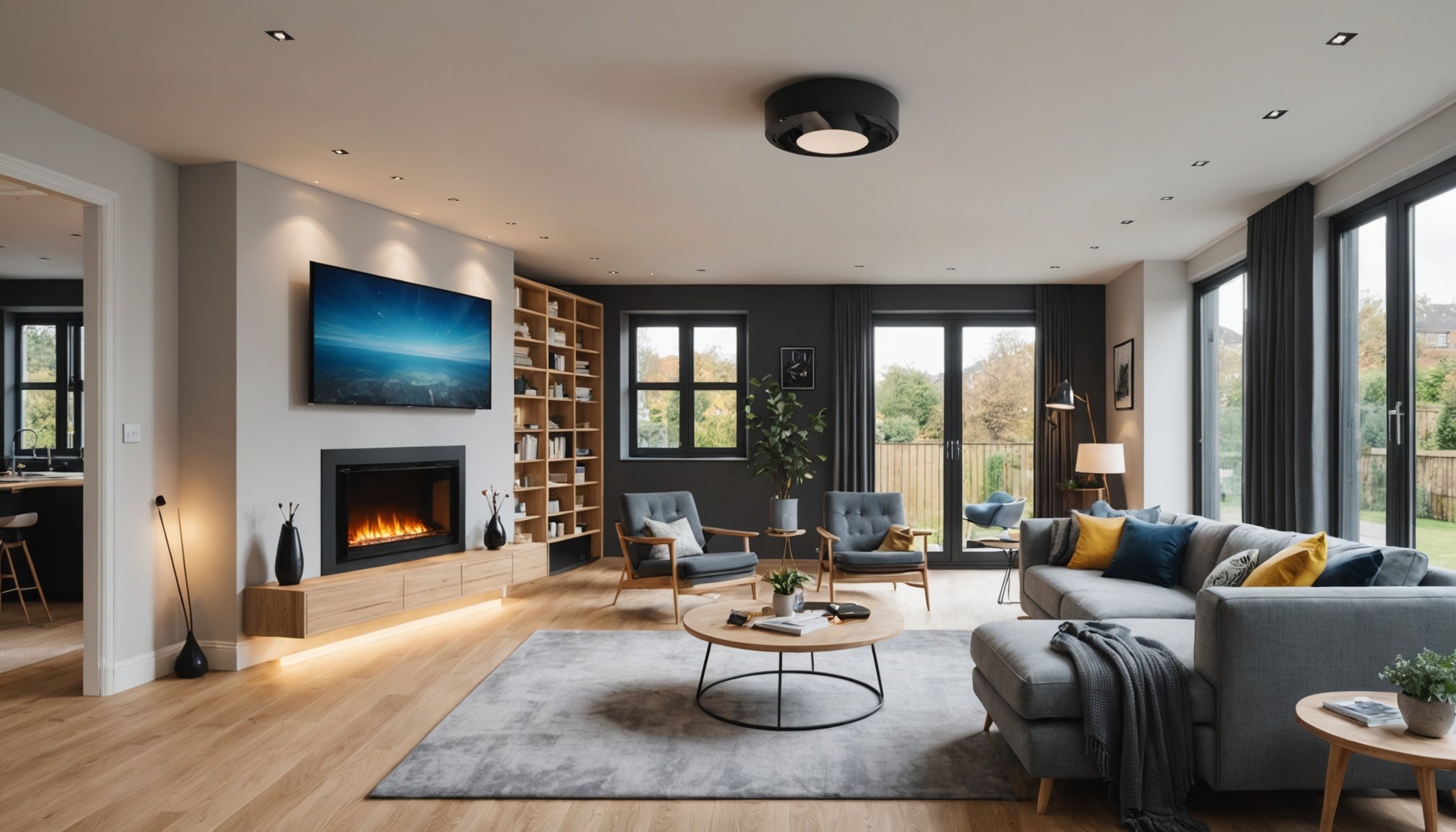Introduction to Smart Home Innovations in 2023
The landscape of smart home technology is evolving rapidly, driven by the increasing demand for more convenient and efficient living environments. The smart home market in the UK is experiencing a significant growth phase, with technological advancements revolutionising how households operate. Homeowners adopting the latest innovations can enjoy enhanced comfort, energy savings, and security within their living spaces.
In 2023, the most prominent trends shaping smart homes include the integration of artificial intelligence, improved energy management systems, and seamless device interoperability. These cutting-edge solutions are enabling homeowners to control various aspects of their homes through intuitive platforms, making daily tasks more straightforward and efficient.
In the same genre : Essential Steps for UK Real Estate Agencies to Effectively Integrate Virtual Tours
Key drivers of these innovations include the desire for sustainable living solutions, the surge in remote working necessitating better home office environments, and the ever-growing importance of security in safeguarding personal spaces. Moreover, the cost-effectiveness of these technologies is becoming increasingly appealing, with competitive pricing making cutting-edge systems more accessible to a broader audience.
Overall, staying ahead with smart home trends in 2023 offers numerous benefits, from increased property value to improved quality of life, positioning this innovation at the forefront of modern living.
This might interest you : Unlocking the power of vallourec smart tubular solutions
Leading Smart Home Technologies of 2023
Smart home devices have increasingly become a staple in modern living. By harnessing automation technologies, these devices offer unbeatable convenience and efficiency. As the market expands, a few standout products deserve attention for their innovation and usefulness.
This year, smart speakers maintain their popularity. Powered by virtual assistants like Amazon Alexa and Google Assistant, they not only play music but also control other smart home devices. Such integration makes organizing daily tasks smoother and more efficient.
On the other hand, smart thermostats like Nest Learning Thermostat are making waves for their energy-saving capabilities. They learn household patterns and adjust the temperature for optimal energy use, offering not only comfort but reduced utility bills.
In the realm of smart appliances, robotic vacuum cleaners are leading the transformation of household cleaning tasks. With advanced navigation and multi-surface cleaning ability, they’re a game-changer for maintaining tidy homes effortlessly.
When comparing automation technologies, Zigbee and Z-Wave remain popular for their low-power consumption and robustness. Yet, Wi-Fi-based systems offer broader compatibility and faster speeds, meeting various user needs more comprehensively. Clearly, 2023 presents an exciting frontier for smart home enthusiasts as technology continues to shape our living spaces.
Enhancing Home Security with Smart Innovations
As smart security systems continue to evolve in 2023, homeowners are offered unprecedented access to safety technology. Leading companies have debuted devices with features that revolutionise home monitoring and enhance security measures.
Among the standout innovations are advanced monitoring and alert systems designed to keep residents informed and secure. These systems employ AI-driven analytics that detect unusual activities and provide real-time notifications, ensuring potential threats are promptly addressed. Enhancements to camera clarity and motion sensors also play a critical role, offering precise surveillance capabilities across large areas.
Many consumers have concerns regarding the intersection of security and privacy. The thought of constant video surveillance could feel intrusive and lead to data privacy anxieties. Consequently, experts advocate for robust encryption protocols and transparent policy disclosures from manufacturers, ensuring personal data remains secure.
With these smart security systems, users have the flexibility to integrate multiple devices within a single network. This connectivity bridges security cameras, alarms, and door locks into a cohesive ecosystem.
Overall, these innovations provide practical, solution-oriented benefits while addressing key safety and privacy worries. As the market expands, it’s crucial for consumers to weigh the merits of each system and select one that aligns with their needs and values.
Energy Efficiency and Sustainability in Smart Homes
With the growing demand for energy-efficient devices, smart homes are increasingly incorporating sustainable technology. Smart thermostats, an integral component of this ecosystem, significantly enhance a home’s energy efficiency. By automatically adjusting heating and cooling based on occupancy patterns and weather conditions, these devices optimise energy use effortlessly.
In the realm of sustainable technology, smart thermostats and similar devices offer numerous benefits. They not only reduce electricity bills but also contribute to environmental conservation by lessening a household’s carbon footprint. For the environmentally conscious homeowner, this means aligning daily living with broader ecological goals.
Real-world examples demonstrate the effectiveness of these devices. UK households, for instance, have reported energy savings of up to 15% after installing smart thermostats. This not only translates to lower costs but also indicates a substantial reduction in energy consumption. With the integration of sensors and other connected devices, homes become more responsive and adaptive to real-time data, further enhancing efficiency.
Investing in energy-efficient devices thus represents a practical approach for those aiming to achieve sustainability at home. This shift towards smart technology offers both immediate and long-term benefits, making a compelling case for a more sustainable lifestyle.
User Convenience Through Smart Home Integration
In today’s fast-evolving tech world, home automation is playing a significant role in enhancing the user experience. Modern homes are increasingly equipped with systems that allow seamless integration of multiple smart devices, paving the way for a truly interconnected living environment.
Overview of Systems Enabling Seamless Home Automation
Smart home systems bring together various intelligent devices through centralized hubs or platforms, allowing them to communicate and work together. This integration offers a streamlined user experience, where lighting, heating, security, and entertainment can be controlled via a simple app or voice command.
Role of Smart Assistants in Everyday Convenience
Smart assistants, like Amazon’s Alexa or Google Assistant, are at the forefront of this transformation. They enable users to interact with their home in a conversational way, facilitate tasks like adjusting the thermostat, setting reminders, or playing music, thereby enhancing everyday life. With voice commands, these smart assistants provide hands-free control, adding a layer of ease and accessibility.
Examples of Integrated Smart Home Solutions
A practical example includes the integration of smart bulbs with a home assistant system, allowing users to control lighting with simple voice commands. Such smart assistants can also manage automated routines, like unlocking doors when the homeowner approaches, thereby ensuring comfort and safety.
Expert Opinions on Future Trends in Smart Homes
Smart home trends are evolving rapidly, with experts attributing significant advancements to the integration of future technology. As industry professionals forecast, smart homes will become more intuitive and seamlessly integrated with everyday life. The convergence of AI and IoT is expected to enhance the functionality and convenience of living spaces.
Industry experts predict that future technology will lead to smart homes that can anticipate residents’ needs through advanced data analytics and machine learning. This could include energy-efficient solutions where systems autonomously optimize consumption, reducing costs for UK homeowners.
Incorporating expert insights, the focus seems to shift towards environmental sustainability and security. Innovations such as smart grids and enhanced security measures will likely lead the charge, promoting not only convenience but sustainable living practices.
The impact of these emerging trends on UK homeowners will be profound. As technology evolves, the adoption of smart home systems will likely increase, providing enhanced comfort and energy savings. Moreover, the value of properties equipped with such technology may see an upswing.
These expert views suggest that the smart home landscape will transform significantly over the next few years, offering promising benefits to homeowners ready to embrace these changes.
User Testimonials and Case Studies
Smart home experiences have significantly evolved, bringing innovation to daily routines. Compiling robust user reviews, narrated stories reveal how these devices transform lives. Notably, seamless connectivity and functionality emerge as core elements in real-life applications.
One particular case study highlights a family’s transition to an automated home. They invested in a series of smart devices, integrating systems such as lighting, security, and climate control. The initial setup posed challenges, specifically concerning device compatibility. However, learning from this, they opted for a centralised hub that aligned multiple brands for successful smart home integrations.
Feedback from users emphasises the importance of clear installation instructions and responsive customer support, offering solutions to common hurdles. These insights illustrate vital lessons learned from user experiences, driving improvements in product development.
Users frequently express satisfaction regarding energy efficiency and cost savings, highlighting the impact of real-life applications. Adaptive thermostats and automated lighting systems contribute notably to these benefits.
From user testimonials, it’s evident that the integration of smart devices offers increased convenience, enhanced security, and energy management. This cumulative feedback is invaluable for potential users considering similar investments, providing a framework for expectations and preparation.
Purchasing and Installation Insights
When venturing into the world of smart home solutions in the UK, it’s crucial to have a thorough buying guide. Start by determining your specific needs and the features you desire in smart home products. Popular items include smart thermostats, lighting, security systems, and voice assistants. Once you identify your needs, research various brands and models, focusing on energy efficiency, compatibility with existing systems, and user reviews.
When it comes to installation services, there are several options available. For simple devices like smart bulbs, you might handle installation yourself. However, more complex systems, such as integrated security networks, often require professional assistance. Many retailers offer installation packages for an additional fee, ensuring your devices are set up correctly and function smoothly.
Finding trustworthy and reliable suppliers and installers is important. Look for companies with positive customer experiences and industry certifications. Some top suppliers also provide extended warranties and post-installation support, offering peace of mind. Trusted providers include well-known brands and specialised smart home retailers with a proven track record in technology spaces.
By following these steps, you can enjoy the seamless integration of smart tech into your home. Embrace the future with confidence and ease.











